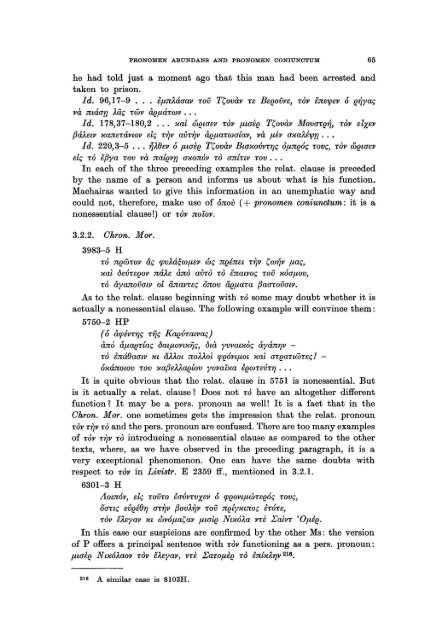Pronomen Abundans and Pronomen Coniunctum. A ... - DWC
Pronomen Abundans and Pronomen Coniunctum. A ... - DWC
Pronomen Abundans and Pronomen Coniunctum. A ... - DWC
Create successful ePaper yourself
Turn your PDF publications into a flip-book with our unique Google optimized e-Paper software.
PRONOMEN ABUNDANS AND PRONOMEN CONlUNCTUM 65<br />
he had told just a moment ago that this man had been arrested <strong>and</strong><br />
taken to prison.<br />
Id. 96,17-9 ... Èf1:JT,Aáaav 'wiJ TCovàv 1'8 BS(JoiJvs, rov lnstpsv ó (J~yaç<br />
và máan Àtiç rwv à(Jfl-árwv . ..<br />
Id. 178,37-180,2 .. , xai w(Jlasv rov fl-lai(J TCovàv Movar(J~, rov ûxsv<br />
{JáÀSLV xansrávlOV ûç rijv avrijv à(Jfl-arwa{av, và fl-iv axaÄétpn . .•<br />
Id. 220,3-5 ... 1}À(hv Ó fl-lai(J TCovàv Blaxovvr'Yjç ofl-n(Jóç rovç, rov w(Jlasv<br />
, '''{J \ I ",<br />
SlÇ ro s ya rov va nat(Jvn axonov ro anlnv rov • ..<br />
In each of the three preceding examples the relat. clause is preceded<br />
by the name of a person <strong>and</strong> informs us about what is his function.<br />
Machairas wanted to give this information in an unemphatic way <strong>and</strong><br />
could not, therefore, make use of ónov (+ pronomen coniunctum: it is a<br />
nonessential clause!) or 'rov noiov.<br />
3.2.2. Chron. Mor.<br />
3983-5 H<br />
ro n(Jwrov aç groAáÇWfl-SV wç n(Jénu rijv Cw~v<br />
IwÇ,<br />
xai &v1'8(Jov náÀs à:n:o avro ro lnalvoç rov xóafl-ov,<br />
ro àyanovaLV oE änav1'8ç onov ö'(Jfl-ara {Jaarovalv.<br />
As to the relat. clause beginning with ro some may doubt whether it is<br />
actually a nonessential clause. The foUowing example will convince them:<br />
5750-2 HP<br />
(ó à((!évr'Yjç rijç KU(JVialVaç)<br />
à:n:o áfl-a(Jr{aç balfl-ovlxfjÇ, blà yvvalxoç ayan'Yjv<br />
ro ÈnáOaalv Xl ä.ÀÀOl noÀÀoi ((!(JÓVlfl-Ol xai ar(Janw1'8ç!<br />
óxánolOv rov xa{JsÀÀa(J{ov yvva'ixa È(Jw1'8vr'Yj ...<br />
It is quite obvious that the relat. clause in 5751 is nonessential. But<br />
is it actuaUy arelat. clause 1 Does not ro have an altogether different<br />
function 1 It may be a pers. pronoun as weU! It is a fa ct that in the<br />
Chron. Mor. one sometimes gets the impression that the relat. pronoun<br />
rov rijv ro <strong>and</strong> the pers. pronoun are confused. There are too many examples<br />
of rov rijv 'ro introducing a nonessential clause as compared to the other<br />
texts, where, as we have observed in the preceding paragraph, it is a<br />
very exceptional phenomenon. One can have the same doubts with<br />
respect to rov in Livistr. E 2359 ff., mentioned in 3.2.1.<br />
6301-3 H<br />
Aotnóv, ûç rovro Èavvrvxsv Ó ((!(Jovlfl-Óns(Jóç rovç,<br />
oanç sV(JéO'Yj arijv {JovÀijv rov n(Jtyxtnoç Èró1'8,<br />
rov lÀsyav Xl wvófl-aCav fl-lai(J NlxóÀa Vii .Eaivr 'Ofl-é(J.<br />
In this case our suspicions are confirmed by the other Ms: the version<br />
of P offers a principal sentence with 'rov functioning as a pers. pronoun:<br />
fl-lai(J NlxóÀaov rov ëÀsyav, vd .Ea'rofl-i(J 'ro ÈntxÀ'Yjv 216.<br />
216 A similar case is 8103H.
















